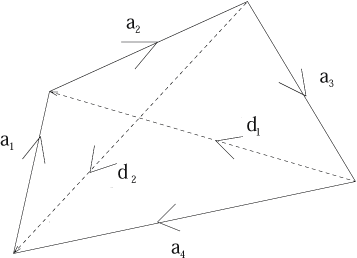Flexi Quads
A quadrilateral changes shape with the edge lengths constant. Show the scalar product of the diagonals is constant. If the diagonals are perpendicular in one position are they always perpendicular?
Problem
Consider a convex quadrilateral $Q$ made from four rigid rods with flexible joints at the vertices so that the shape of $Q$ can be changed while keeping the lengths of the sides constant. Let ${\bf a}_1$, ${\bf a}_2$, ${\bf a}_3$ and ${\bf a}_4$ be vectors representing the sides (in this order) of an arbitrary quadrilateral $Q$, so that ${\bf a}_1+{\bf a}_2+{\bf a}_3+{\bf a}_4 = {\bf 0}$ (the zero vector). Now let ${\bf d}_1$ and ${\bf d}_2$ be the vectors representing the diagonals of $Q$. We may choose these so that ${\bf d}_1={\bf a}_4+{\bf a}_1$ and ${\bf d}_2={\bf a}_3+{\bf a}_4$. Prove that
$${\bf a}_2^2+{\bf a}_4^2-{\bf a}_1^2-{\bf a}_3^2= 2({\bf a}_1{\cdot}{\bf a}_3-{\bf a}_2{\cdot}{\bf a}_4).\quad (1)$$
and that the scalar product of the diagonals is constant and given by:
$$2{\bf d}_1{\cdot}{\bf d}_2 = {\bf a}_2^2+{\bf a}_4^2-{\bf a}_1^2-{\bf a}_3^2.\quad (2)$$
Use these results to show that, as the shape of the quadrilateral is changed, if the diagonals of $Q$ are perpendicular in one position of $Q$, then they are perpendicular in all variations of $Q$.
Getting Started
Use the scalar product of the diagonals. As the quadrilateral is flexed the diagonals change but the lengths of the sides are constant. All the vectors change but the the squares of the vectors of the sides (representing the lengths) remain constant. To preserve symmetry and obtain this scalar product in the form required, write
$$2{\bf d}_1={\bf a}_1-{\bf a}_2-{\bf a}_3+{\bf a}_4, \quad 2{\bf d}_2=-{\bf a}_1-{\bf a}_2+{\bf a}_3+{\bf a}_4.$$
Student Solutions
This excellent solution came from Shu Cao of Oxford High School. Well done Shu!

Teachers' Resources
Why do this problem?
Students often see simple geometric proof problems using vectors. This problem involves more demanding algebra including a strong grasp of the meaning of the scalar product, its properties and its relationship with the magnitude of a vector.
Possible approach
This problem would suit independent work by individual students with minimal prompts only when necessary. All students should draw a diagram using the information given in the question and write down any relationships they are given or can see from their diagram. There is more than one possible route to proving each statement. Possible prompts might include referring to any given information or information from the diagram a studnet may be neglecting and also clarification about the distributive property of the scalar product and the meaning of the scalar product of a vector with itself. It is important that students are able to explain the implications of the results once they have been proven algebraically.
Key questions
Which vectors can be written as the sum of other vectors in this situation? Can any be written in more than one way?
If the length of vector ${\bf n}$ is $n=|{\bf n}|$, how can we express $n$ in terms of the scalar product?
How can we simplify $({\bf a} + {\bf b})\cdot({\bf a} + {\bf b})$?
Possible extension
Tetra Perp is a similar problem using the scalar product in a geometrical proof.
Possible support
The article Multiplication of vectors may help to remind students of the basic definition of the scalar product.
